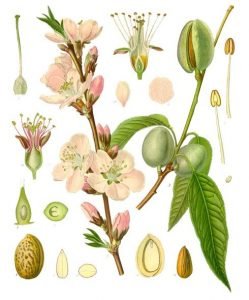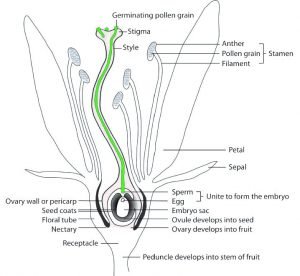
The origin of almond is Western Asia and the Middle East. It is Native to the Mediterranean climate. Cultivation of almond in North America and small Quantity California during 1959 there was 7044531 trees. The average yield of almond during years of 1961-67 was 183000 tons. The variety which is present in California came from southern Europe and North America. Most organic varieties are Perennial in nature. In Pakistan and India almond is known as a badam. During the old time almond came into North Africa and South Europe and recent past it travelled to California and United States. Almond also has a wild form which is present in the Levant, almond first cultivated in this region. The wild form of almond has Glycoside Amygdalin that converts into hydrogen cyanide after any damage. Almond is the first cultivated plant among nuts. Wild Almond has a bitter taste and mechanically Hard and produce cyanide. Wild types of almond produce toxins which are not produced by cultivated almond. It is said that sweet almond originated through mutation in the genetic material of bitter almond (Jared Diamond). The domestication of almond occurred during (2000-3000BC) and the fruit of almond first found in Egypt.
Geographical distribution
Almond has a large geographical allocation of wild species through the southwest, Turkey, Syria, Iran, the desert of Tian-Shan and Hindu Kush Mountains. It also considered that there is the distribution of 30 species, but due to some reasons, this distribution is not absolute like polymorphism and the Existence of races. These species divided into four groups; 1) Section Euamygdalus; the tree size is moderate and are present at 1500m height in Turkey. 2) Section Chanae amygdalus; present in southern and central Russia and also present in Turkistan. 3) Section spartiods; at 1500m height in central Iran, and 4) Section Lycioides; Iran, at 300-1500m height. The family of cultivated almond is Rosaceae. The subfamily is prounoideae. Some almonds have different genus.
Growth
Almond has decorative effects because it has early pink blooms. It is not productive when early flowering occurs in almond the frost and cold air damages the flowers. It is the crop which is bloom in spring as it responds readily to warm temperature and also for its relatively low chilling requirements. It is the main reason of low yielding in almond. An ideal condition for the strong almond culture is the Mediterranean type of climate which has mild winter combined with the frost tree and rainless spring and warm summer for the nuts ripening.
There are two types of almond i.e. bitter and sweet almond. Most of the nuts of sweet almond (Prunus amygdulus) are used for confectionary and also for a desert purpose. Bitter almond, which is known as Prunus amygdulus amarus, used for Icing and Marzipan and in some flavoring agent but it can not use for the desert purpose. Both sweet and bitter almond have the same appearance, but bitter almond has a small amount of the hydrocyanic acid. So it produces the bitter taste in the nuts.
The treatments in cultural practices for almond are same as peaches. Almond can grow on any soil either soil have fragile texture or stony material. Whenever almond tree grows in heavy clay soil, the plant has a significant progress. Only a small amount of pruning is required. Almond grows from seeds or nuts for the production of varieties almond scion should be grafted on almond or plum rootstock. Almond has a double variety which cannot produce seeds. When nuts begin to fall, then it is considered that crop is ready for harvesting. At this time shells start to break. Sometimes shells of nuts so hard that it is hard to break them. Almond fruit has three layers i.e. exocarp which is pubescent, mesocarp and endocarp. Almond is the oldest crop which is used by human beings but due to the small environmental adaptation production is restricted only in the low region of the world. The cultivated almond Prunus amygdalus belong to a family Rosaceae and subfamily Prunoideae. The genus Prunus has more than 30 species which show a broad range of geographical and morphological forms. Italy, Spain, Iran, Morocco and Portugal are major almond producing countries.
Chemical Composition
Calcium 234 mg
Phosphorus 500 mg
Magnesium 625 mg
Ash 3 mg
Vitamin 0
Fiber 3 mg
Carbohydrates 20 mg
Proteins 19 mg
Thiamine 0.24 mg
Sodium 4 mg
Potassium 770 mg
Ascorbic acid trace
Botany
It is a deciduous plant. Tree size is a practical term which not only depends on the distinct almond genotype but also upon the orchard age, location (environmental condition) and organization (irrigation, fertilization, and pruning). Size is related to the precocity and productivity. The size of the different tree is directly associated with the yield and must be stable against the tree arrangement and density to improve the production per acre. A most excellent cultivar of the Prunus dulcis falls inside the tree size ranging of intermediate to large size, dependent upon the stage and place. Size difference among the almond species is greater than within the Prunus dulcis, with some species (e.g., P. webbii, P. argentea, P. fenzliana) being quite small and shrubby. The height of almond tree is up to 13-33 feet (4-10m) and with the diameter of logwood is about 30 cm.
Almond trees have distinct shapes determined by angle and amount of branches primarily. Sometimes vigor and size may also have related to the branching habits. Vigorous tree rottenly upright and tend to be large. Weaker trees have a wide angle and small size. Tree with the intermediate shape between the two extremes is desirable. Shapes appear to be quantitatively inherited, often being intermediate between the two parents. Young branches are green in color and become purple under the sunlight during 2nd-year branches become gray in color. Leaves length about 3 to 5 inches, the margin of leaves scattered up to some extent. The petiole is about 2.4 cm.
It has two colors of flowers, white flowers and pale pink which have a 2-4 cm diameter. Petals are five. May be single or in the form of pairing. The flowers of the different cultivars and species may change in the number of stamens, size of the petal, color, and form, and arrangement and size of anthers relative to the stamens. The number of stamens may differ from 20-40, with the usual number being 30 to 33. Although the carple is one and some genotype (Eureka) have a tendency to produce two carples, and doubling of the fruits may take place as a result, and a potential to enhance the output. The carple also has the different structure. Some carples are erected and elongated, spreading above the anthers, by the bee a trait that has linked with the enhanced cross-pollination. In the other individuals, the stigma and anthers are close to the same level, a situation that related with the more chances of self-pollination. In some other plants, the pistils are not straight they are bent, twisted and modified to the different forms that mostly depend on the age of flowers.
Present day the cultivated Prunus have the two distinct groups; one group grown for its nuts or kernels and other group grown for flowering or as ornamental. The former belongs to the Prunus dulcis and late to the p. triloba, p. glandulosa and p. Japonica and valued for their white, glowing or rose, single or double flowers. The almond kernels for their high oil content are the rich source of concentrated energy. The oil of almond contains the linoleic fatty acid and oleic fatty acid and contains the important contents of protein, some vitamins like riboflavin, thiamine, and niacin. Contain the minerals mainly Ca, P, K, and Mg. Economic fruit production starts in almond after three years of plantation and full production starts after six years.


Breeding methods
Different propagation methods and molecular markers like SSR, RAPID and RFLP used for the improvement of the available germplasm. Desirable genes introduced in germplasm by using the tissue culture techniques and embryo culture technique. Aneuploidies also help in the genetic study of almond. Breeding of almond started in 1971. During 1981 about 81 cultivars collected from Spain and introduced into different regions of the world. First crossing in almond done in 1985.There were two objectives of this crossing i.e. Self-incompatibility and late flowering. When the late flowering occurs in almond, it outflows from frost damage, and due to self-incompatibility, only one genotype can grow in the garden.
Stratification required for the proper germination of almond seed (seeds are dripping in water for 10-20 hours). During the first year, crosses made in spring season after germination of the seeds in the greenhouse. First, we choose male and female plants. Female flowers emasculated and pollinated by the pollen of the male flower. In 2nd-year crossed seeds planted in the nurseries and 3rd-year desirable almond trees, grown at 3-6ft. In fourth -year flowering provoked but minimized by pruning and 5th-year flowers and fruit formed, preliminary trials conducted. In 6th-year real fruit-bearing occurs, if the environment is suitable, then further trials conducted for seed multiplication and distribution. The breeding period can be reduced using molecular markers.
Uses
Almond used as a raw, toasted or in different dishes. The sweet nuts which are utilized as a fresh or prepared either branched or unbranched, salted, roasted, used mostly in the formation of confectionary or processed products like ice cream, biscuits, chocolates, candies. The nuts husk utilized for animal feed. Almonds oil is utmost effective for the human brain. A few almonds every day aids in refining remembrance and attentiveness, particularly in children. It is also thought to make offspring shrill and energetic. It also used in making the perfume products, baby oil, for good human skin and massage. Almond maintains the cholesterol level by increasing the HDL and decreasing LDL, so it used in medicine. The almond used as an essential ingredient of the ancient Ayurveda and Tibb-e-Unani systems of human treatment since time immemorial. Sweet almonds used as a laxative as well as in the treatment of a dry cough in the children.
Health constraints
A small amount of almond has beneficial effects on human’s health but overdosage cause defects such as high weight and high blood pressure. It has manganese which interacts with medicine. An overdose of vitamin E which is not suitable for health causes gastrointestinal problems. Bitter almond has Hydrocyanic acid which is toxic to human health.
Scope in Pakistan
Almond production in Pakistan is deficient due to the early shedding of flowering by frost. In Pakistan, Baluchistan is the major producer of almonds; production in other provinces is negligible. Pakistan produced about 26,487 tons of almonds during 2008-2009 from an area of 11,002 hectares. However, we still need to import hulled and unshelled almonds from abroad to meet the domestic demand. In Pakistan, almonds are used not only as an essential ingredient of Indian Ayurveda and Tibb-e-Unani therapies but shelled almonds also have many traditional uses in household cuisines and the preparation of sweet dishes.
This article is jointly authored by Yousif Shafiq1, Zahoor Ahmad2* and Sajjad Akhtar3-_1Department of Plant Breeding and Genetics, University of Agriculture Faisalabad, 2Cholistan Institute of Desert Studies, The Islamia University of Bahawalpur, 3Department of Plant Sciences (Plant Breeding) university of Free State, Bloemfontein, South Africa.